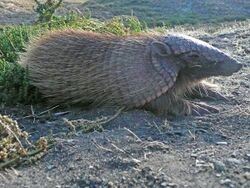Biology:Euphractinae
| Euphractinae | |
|---|---|

| |
| Chaetophractus vellerosus | |
| Scientific classification | |
| Domain: | Eukaryota |
| Kingdom: | Animalia |
| Phylum: | Chordata |
| Class: | Mammalia |
| Order: | Cingulata |
| Family: | Chlamyphoridae |
| Subfamily: | Euphractinae Winge 1923 |
| Genera | |
| |
Euphractinae is an armadillo subfamily in the family Chlamyphoridae.
Euphractinae are known for having a well developed osteoderm that has large cavities filled with adipose tissue, and more hair follicles with well developed sebaceous glands in comparison to the Dasypodidae sub family. These are believed to be evolutionary adaptations in the Euphractinae to support it in the cooler climate that it usually lives in.[1]
Taxonomy
It contains the following genera:[2]
- Chaetophractus, hairy armadillos
- Euphractus, six-banded armadillos
- Zaedyus, pichis
Extinct genera include:[3]
- Paleuphractus
- Doellotatus
- Proeuphractus
- Macroeuphractus
Phylogeny
A mitochondrial DNA investigation has concluded that Euphractinae is the sister group of a clade consisting of Chlamyphorinae (fairy armadillos) and Tolypeutinae (giant, three-banded and naked-tailed armadillos)[4] along with extinct glyptodonts,[5] as shown below.
| Cladogram[5][6][7] | |||||||||||||||||||||||||||||||||||||||||||||||||||||||||||||||||||||||||||||||||||||||||||||
|
References
- ↑ Krmpotic, C.M.; Ciancio, M.R.; Barbeito, C.; Mario, R.C.; Carlini, A.A. (2009). "Osteoderm morphology in recent and fossil euphractine xenarthrans". Acta Zoologica 90 (4): 339–351. doi:10.1111/j.1463-6395.2008.00359.x.
- ↑ "Euphractinae". Integrated Taxonomic Information System. https://www.itis.gov/servlet/SingleRpt/SingleRpt?search_topic=TSN&search_value=727507.
- ↑ Mitchell, Kieren J.; Scanferla, Agustin; Soibelzon, Esteban; Bonini, Ricardo; Ochoa, Javier; Cooper, Alan (2016). "Ancient DNA from the extinct South American giant glyptodont Doedicurus sp. (Xenarthra: Glyptodontidae) reveals that glyptodonts evolved from Eocene armadillos". Molecular Ecology 25 (14): 3499–3508. doi:10.1111/mec.13695. PMID 27158910. http://sedici.unlp.edu.ar/handle/10915/101557.
- ↑ Gibb, G. C.; Condamine, F. L.; Kuch, M.; Enk, J.; Moraes-Barros, N.; Superina, M.; Poinar, H. N.; Delsuc, F. (2015-11-09). "Shotgun Mitogenomics Provides a Reference Phylogenetic Framework and Timescale for Living Xenarthrans". Molecular Biology and Evolution 33 (3): 621–642. doi:10.1093/molbev/msv250. PMID 26556496.
- ↑ 5.0 5.1 Delsuc, F.; Gibb, G. C.; Kuch, M.; Billet, G.; Hautier, L.; Southon, J.; Rouillard, J.-M.; Fernicola, J. C. et al. (2016-02-22). "The phylogenetic affinities of the extinct glyptodonts". Current Biology 26 (4): R155–R156. doi:10.1016/j.cub.2016.01.039. PMID 26906483. https://hal.archives-ouvertes.fr/hal-01879335.
- ↑ Upham, Nathan S.; Esselstyn, Jacob A.; Jetz, Walter (2019). "Inferring the mammal tree: Species-level sets of phylogenies for questions in ecology, evolution and conservation". PLOS Biol 17 (12): e3000494. doi:10.1371/journal.pbio.3000494. PMID 31800571.
- ↑ Gibb, Gillian C.; Condamine, Fabien L.; Kuch, Melanie; Enk, Jacob; Moraes-Barros, Nadia; Superina, Mariella; Poinar, Hendrik N.; Delsuc, Frédéric (2015). "Shotgun Mitogenomics Provides a Reference PhyloGenetic Framework and Timescale for Living Xenarthrans". Molecular Biology and Evolution 33 (3): 621–642. doi:10.1093/molbev/msv250. PMID 26556496.
Wikidata ☰ Q241430 entry
 |

